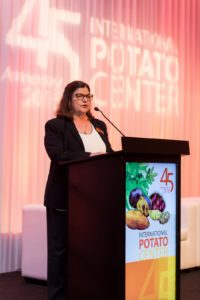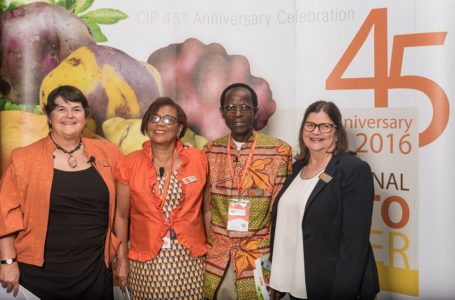 To help us put our 45th anniversary into context, we spoke with CIP’s Director General Barbara Wells about gender in agriculture and science, the World Food Prize and CIP’s future.
To help us put our 45th anniversary into context, we spoke with CIP’s Director General Barbara Wells about gender in agriculture and science, the World Food Prize and CIP’s future.
Q. You’re the fourth person to head the organization. What changes have you observed in the discussion about food security since you began in 2014?
CIP had already been a well-respected and accomplished research for development organization when I joined. In the years since, the two biggest things that have happened were the UN’s adoption of the Sustainable Development Goals and the Paris Agreement on climate change.
CIP’s work is consistent with 11 of the 17 SDGs; of those 11, our work is perfectly aligned with the Goals around Ending Poverty, Eliminating Hunger, Gender Equality, Climate Action, and Life on Land, all of which have been deeply embedded in all six of our programs. Cross-cutting to everything we do is gender equity and climate resilient responsiveness to climate change.
We have also made significant progress toward achieving impact at scale on the ground across the continents where we work. In the past year, CIP has seen advancements on many fronts. One result that particularly stands out is having reached more than two million households with orange-fleshed sweetpotato (OFSP), contributing to the elimination of childhood blindness and contributing to the reduction in stunting.
Another result has been raising awareness about the importance of quality seed in South America and Africa. In Ecuador, the National Agriculture Research Institute has begun producing tons of seed potatoes to ensure the quality and yield of the country’s potato harvest. They have set a goal of increasing the supply of quality seed by more than 600% by 2018. In Sub-Saharan Africa, CIP coordinated a seed systems community of practice for OFSP that allows scientists to share knowledge and best practices. While these are just two efforts to ensure quality seed systems, they are fantastic examples of how progress can be made at the both the grassroot and grasstop levels to have an impact.
2015 also marked a positive year for upstream research having an impact in the field. In promising research coming out of Uganda, CIP has seen positive results from confined field trials with late blight-resistant potatoes using transgenic events with the 3 R genes in two popular potato varieties. Attaining durable late blight resistance has been a goal of potato research for decades; initial results from 2015 indicate that we are close to overcoming it.
Q. You are also the second woman to lead CIP and a trained agronomist. How do you view the role of women in science changing as we look to the years ahead? What can schools, workplaces and research centers like CIP and CGIAR do now to continue to attract women to science and research careers?
I think we need to continue to walk the talk. Anecdotally, I have seen the perspective that women scientists bring to our work and broaden our perspectives and decision-making processes. This is true especially when it comes to doing gender-inclusive research. A large majority of smallholder farmers are women: when they interact with a woman scientist in the field and feel a greater level of comfort and connection, this can result in different types of interventions. From a People and Organizational Development perspective, CIP also monitors this; while we are improving in employing women in science roles, we can always strive to do better.
One of our strengths is working with partners to develop capacity of smallholder farmers to produce potato and sweetpotato. These cash crops are not only particularly resilient to climate change, they are harvested in the hunger months, thereby contributing to income and hunger alleviation while farmers await grain harvest season. Recently CIP hosted a session of a summer camp program for girls in science, technology, engineering, arts and math (STEAM). I was pleased to see so many young women interested in the same fields I know and love. I look forward to the day gender inclusion is simply the norm in all we do.
Q. Another prominent woman who helps raise awareness of potato and sweetpotato’s worth is Nane Annan. How has CIP’s partnership with Mrs. Annan grown over the years?
Over the past year and a half of her involvement with CIP, Nane (and her husband Kofi) Annan have become passionate about the vitamin A-rich biofortified crop OFSP and the means it provides to prevent childhood blindness and contribute to reduction in stunting in children under 5 and to develop a full value chain approach for job creation for youth, women and men in the post-harvest processing business opportunities.
ane is rightfully called an ambassador for OFSP. She has lent her enthusiastic support for sweetpotato through advocacy and education tours in Ghana, where the potential impact for sweetpotato to improve thousands of women and children’s nutritional status is immense. In her three advocacy tours with CIP, she has vowed to work with others to promote OFSP to smallholder farmers and producers to their mutual benefit. Her dedication to the communities of Ghana and Western Africa is admirable. It has been an absolute pleasure to work with her over this past year and a half to help achieve our shared agendas.
Q. Discuss the global role of potato and OFSP as a source of nutrients, hunger relief and farming livelihood. While it’s been consumed for millennia in some parts of the world, it’s a relatively new crop in others. How does the expansion of potato and sweetpotato crops around the world shape CIP’s mission?
A billion people eat potato around the world across 140 countries. Another 600 million eat sweetpotato. There is no doubt that both crops are important and they are both very nutritious.
What’s critical is a nutritious “food basket” approach. While we are experts in potato and sweetpotato, we must ensure that they coexist with other crops and livestock so that people in developing countries have well-balanced diets. With this in mind, it is important that CIP work with partners to achieve this. We also have our focus on biofortification to ensure that the potatoes and OFSP that farmers grow and their customers eat are nutrient-packed. We have already done this with OFSP.
Q. CIP this year received the highest award in agricultural development – the World Food Prize. What was your initial reaction upon hearing the news? What can you tell about the three WFP Laureates who are part of CIP?
This is not only a great honor for CIP and for the Laureates, it is validation of CIP’s early work to bridge agriculture and nutrition.
With evidence data now firmly in hand and paving the way other biofortified crops now being launched, all three scientist deserve credit for their contributions to this:
- Jan Low for making the case for orange-fleshed sweetpotato as an acceptable food in the diets of Sub-Saharan Africa
- Maria Andrade for developing numerous varieties of sweetpotato that are well accepted in southern and eastern Africa and for training numerous other breeders throughout the region. Moreover, Maria has been a great advocate for breeding in Africa for Africa which, in its own way, is revolutionary and incredibly successful
- Robert Mwanga for keeping sweetpotato as a priority crop in Uganda and for breeding the number of varieties in Central Africa that he has, not to mention the training and capacity strengthening efforts that he has done in the region
CIP is very proud of these three scientists and the teams that have supported them in achieving this honor. I also want to recognize Howdy Bouise of HarvestPlus who has been a tireless advocate for biofortification and a great partner to CIP.
Q. How might receipt of the WFP shape CIP’s mission going forward?
The World Food Prize is positive recognition of biofortification as an agricultural for nutrition intervention. CIP’s pipeline includes a potato biofortified with iron, zinc or both as well as continuing our efforts to further biofortify sweetpotato. We must ensure that countries that with significant levels of hidden hunger as a result of vitamin A deficiency or anemia due to Fe or ZN deficiency consider potato and sweetpotato as crops that could help curb these diseases.
Our goal is to expand upon our success with OFSP in Sub-Saharan Africa as well as in Asia and Haiti. We also see a great need for biofortified potato in its center of origin in South America as well as parts of Central Asia.
Q. In a changing climate, with water becoming increasingly scarce, sweetpotato and potato serve as safeguards against hunger. How does CIP’s work serve as a safeguard for future generations?
Both potato and sweetpotato are inherently climate resilient crops in that they are naturally drought tolerant and are resistant to extreme weather shock such as flooding. Potato and sweetpotato, like all crops, are also sensitive to variations in temperature, water availability and relative humidity. For CIP, it is paramount that if the needed counteractive measures –such as the adoption of tolerant varieties and management strategies- are not implemented in time, food security, malnutrition, human health, and increased poverty will increase in developing countries as the likely reduction in potato and sweetpotato production under climate change will affect mainly the poor population. CIP has started to undertake active research to maintain and enhance the quality and resilience of these crops under climate change conditions.
